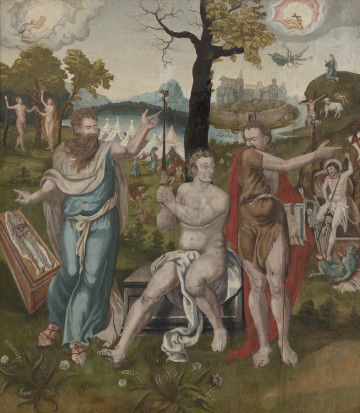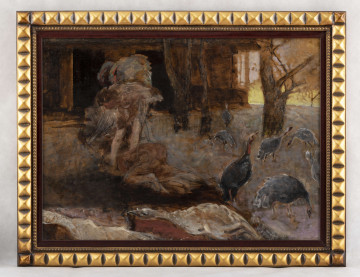
Wrota (Drzwi) | Gates (Door)
1996
National Museum in Szczecin
Part of the collection: European painting
Vanitas vanitatum et omnia vanitas (Vanity of vanities and all is vanity) – these words from the biblical Book of Kohelet express the eternal truth about the inevitable passing of all things. Vanitas as a separate painting genre developed in Europe in the early 17th century and was closely related to the experiences of the Thirty Years' War and the raging plague epidemic. The feeling of helplessness in the face of the constant threat of loss of life and property intensified the conviction of the futility of earthly existence. Painters, depicting the beauty and wealth of the material world, remind us that everything is impermanent, that time passes inexorably and that the spectre of death accompanies each life.
At first glance, The Still Life – Birds and Butterflies represents a popular hunting trophy subject. The birds lying on the ground – a snipe, a pheasant, a plover, a goldfinch – are painted realistically, but the dark, gloomy background lit up by a bloody glow at the bottom introduces a strong emotional charge. The horror of death is intensified by the dramatically outlined claws of a dead bird against this background. There are also representations whose hidden meaning was clear to the viewer of those times. The thistle appears already in the Bible as a symbol of the world outside paradise – full of difficulties, suffering and various tribulations. The fly, like other insects, symbolises the shortness of life but has an additional negative meaning connected with spoilage and decay. It was supposed to be at the service of the devil, whose Semitic name Beelzebub meant 'lord of flies and mosquitoes'. In contrast, the butterflies in the painting – a nettle, a peacock butterfly, a whitethroat – carry positive content. In ancient Greece, the butterfly (psyche) denoted both an insect and the human soul. In Christian art, the transformation of a caterpillar into a butterfly became a symbol of resurrection and new life after death. The evergreen ivy, challenging to uproot, has a similar meaning. Climbing up a solid stone pillar symbolises the eternal life that springs from steadfast faith.
Barbara Czajkowska
Author / creator
Dimensions
cały obiekt: height: 41 cm, width: 50 cm
Object type
painting
Technique
oil technique
Material
canvas, oil-based paint
Creation time / dating
Creation / finding place
Owner
The National Museum in Lublin
Identification number
Location / status

1996
National Museum in Szczecin

circa 1567 — 1600
National Museum in Szczecin

National Museum in Lublin
DISCOVER this TOPIC
National Museum in Lublin
DISCOVER this PATH
Educational path